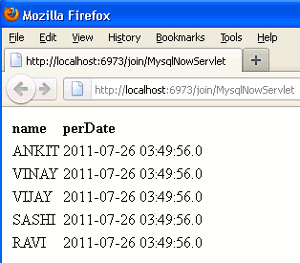In this section we will discuss how can you find the current system date and time.
Mysql NOW() function SELECT using Java Servlet
In this section we will discuss how can you find the current system date and time.
NOW() function is used to find the current system date and time. This function can be used with select statement as "SELECT NOW()", but if we want to use this function in table then the select statement is use as " SELECT NOW() FROM table_name". Since I have to use this query in java program therefore, I created a class in java named MysqlNowServlet which extends the HttpServlet class. In the body of class I overridden the method doGet() and created an objects of HttpServletRequest and HttpServletResponse into its parameter. Inside the doGet() method first I set the mime type that in which format the browser will show the output. In the next line I used the getWriter() method of ServletResponse interface with the object of HttpServletResponse. HttpServletResponse interface extends this method from the ServletResponse. In continue since we have to use a SQL query so at first we will have to make a connection between java code and database system. I am using here Mysql so in the example given below I am loading the driver of mysql and make a connection by using the getConnection() method of DriverManager class. It returns a Connection. Now I have a table 'employee' that I had created in mysql earlier. So I did not need to create a table here. Further I passed the query "SELECT name, now() AS perDate FROM employee", to show the current system date and time into the table, into the parameter of prepareStatement() method of Connection interface which gives an object of PreparedStatement interface. In the next line I used the executeQuery() method of PreparedStatement interface which returns an object of ResultSet interface from which I extract the records.
Example :
import java.io.IOException;
import java.io.PrintWriter;
import java.sql.SQLException;
import java.sql.DriverManager;
import java.sql.Connection;
import java.sql.PreparedStatement;
import java.sql.ResultSet;
import javax.servlet.ServletException;
import javax.servlet.http.HttpServlet;
import javax.servlet.http.HttpServletRequest;
import javax.servlet.http.HttpServletResponse;
public class MysqlNowServlet extends HttpServlet
{
Connection con;
PreparedStatement ps;
ResultSet rs;
public void doGet(HttpServletRequest req, HttpServletResponse res)
throws IOException, ServletException
{
PrintWriter pw = res.getWriter();
res.setContentType("text/html");
String driver = "com.mysql.jdbc.Driver";
String url = "jdbc:mysql://192.168.10.13/data";
String uid = "root";
String psw = "root";
String sql = "SELECT name, now() AS perDate FROM employee";
try {
Class.forName(driver);
con = DriverManager.getConnection(url, uid, psw);
ps = con.prepareStatement(sql);
rs = ps.executeQuery();
pw.println("<table>");
pw.println("<tr><td><b>name</b></td>");
pw.println("<td><b>perDate</b></td></tr>");
while (rs.next())
{
String name = rs.getString(1);
String perDate = rs.getString(2);
pw.println("<tr>");
pw.println("<td>" + name + "</td>");
pw.println("<td>"+ perDate + "</td>");
pw.println("</tr>");
}
pw.println("</table><br>");
} catch (SQLException sx)
{
pw.println(sx);
} catch (ClassNotFoundException cx)
{
pw.println(cx);
}
}
}
web.xml
<?xml version="1.0" encoding="UTF-8"?> <web-app id="WebApp_ID" version="2.4" xmlns="http://java.sun.com/xml/ns/j2ee" xmlns:xsi="http://www.w3.org/2001/XMLSchema-instance" xsi:schemaLocation="http://java.sun.com/xml/ns/j2ee http://java.sun.com/xml/ns/j2ee/web-app_2_4.xsd"> <display-name>join</display-name> <servlet> <servlet-name>MysqlNowServlet</servlet-name> <servlet-class>MysqlNowServlet</servlet-class> </servlet> <servlet-mapping> <servlet-name>MysqlNowServlet</servlet-name> <url-pattern>/MysqlNowServlet</url-pattern> </servlet-mapping> </web-app>
Output :
When you will execute the above example you will get the output as :



[ 0 ] Comments